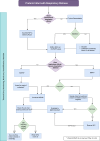Noninvasive Ventilation Strategies in Neonates
- PMID: 40299251
- PMCID: PMC12106148
- DOI: 10.1007/s13312-025-00077-7
Noninvasive Ventilation Strategies in Neonates
Abstract
We provide recommendations on neonatal noninvasive ventilation (NIV) strategies used in the delivery room (DR) and neonatal intensive care unit (NICU). A systematic search was performed in the PubMed, Embase, and CENTRAL databases to identify relevant literature from the past 5 years. A critical review of the available literature was conducted to provide context-specific recommendations. In the DR, we recommend using nasal continuous positive airway pressure (NCPAP) or nasal intermittent positive pressure ventilation (NIPPV) with a T-piece resuscitator (TPR). Surfactant replacement therapy should be administered early (< 2 h of life) in infants requiring NCPAP of 6-7 cm H2O and FiO2 > 0.3, using less invasive surfactant administration techniques. Infants should be transported to the NICU on positive pressure support using NCPAP or TPR. In extremely preterm infants with severe respiratory distress requiring intubation in the DR, surfactant should be considered during the intubation. If equipment and expertise are available in the NICU, NIPPV is the preferred mode of NIV. Nasal masks or short binasal prongs are the preferred nasal interfaces. A heated, humidified, high flow nasal cannula is not recommended as the primary mode of NIV. Additional clinical trials are needed for nasal high frequency ventilation and noninvasive ventilation neurally adjusted ventilatory assist modes of NIV. Guidelines for the recommended initial and maximal settings for primary, post-extubation, and weaning off NIV in neonates are provided in this article. NIPPV and NCPAP are the preferred modes of NIV in neonates with respiratory distress.
Keywords: HHHFNC; NCPAP; NHFV; NIPPV; NIV; NIV-NAVA; Preterm; RDS.
© 2025. The Author(s).
Conflict of interest statement
Declarations. Conflict of interest: None. Ethical Approval: Not applicable. Consent to Participate: Not applicable. Consent to Publish: Not applicable. Human Ethics: Not applicable. Clinical Trial Number: Not applicable.
Figures
Similar articles
-
Non-Invasive Ventilatory Support in Preterm Neonates in the Delivery Room and the Neonatal Intensive Care Unit: A Short Narrative Review of What We Know in 2024.Neonatology. 2024;121(5):576-583. doi: 10.1159/000540601. Epub 2024 Aug 22. Neonatology. 2024. PMID: 39173610 Free PMC article. Review.
-
A Review on Non-invasive Respiratory Support for Management of Respiratory Distress in Extremely Preterm Infants.Front Pediatr. 2020 May 28;8:270. doi: 10.3389/fped.2020.00270. eCollection 2020. Front Pediatr. 2020. PMID: 32548084 Free PMC article. Review.
-
Non-invasive neurally adjusted ventilatory assist (NIV-NAVA) reduces extubation failures in preterm neonates-A systematic review and meta-analysis.Acta Paediatr. 2024 Sep;113(9):2003-2010. doi: 10.1111/apa.17261. Epub 2024 May 4. Acta Paediatr. 2024. PMID: 38703014
-
Noninvasive Neurally Adjusted Ventilation versus Nasal Continuous or Intermittent Positive Airway Pressure for Preterm Infants: A Systematic Review and Meta-Analysis.Children (Basel). 2023 Dec 18;10(12):1935. doi: 10.3390/children10121935. Children (Basel). 2023. PMID: 38136137 Free PMC article. Review.
-
Comparison of three different noninvasive ventilation strategies as initial respiratory support in very low birth weight infants with respiratory distress syndrome: A retrospective study.Arch Pediatr. 2020 Aug;27(6):322-327. doi: 10.1016/j.arcped.2020.06.002. Epub 2020 Jul 7. Arch Pediatr. 2020. PMID: 32651144
Cited by
-
Bubble NIPPV: Guidelines for Use.Children (Basel). 2025 Jun 25;12(7):834. doi: 10.3390/children12070834. Children (Basel). 2025. PMID: 40723027 Free PMC article.
References
-
- De Luca D, Tingay DG, van Kaam AH, et al. Epidemiology of neonatal acute respiratory distress syndrome: prospective, multicenter, international cohort study. Pediatr Crit Care Med. 2022;23:524–34. - PubMed
-
- Tribolet S, Hennuy N, Rigo V. Ventilation devices for neonatal resuscitation at birth: a systematic review and meta-analysis. Resuscitation. 2023;183:109681. - PubMed
-
- Guideline 13.4. Airway management and mask ventilation of the newborn [Internet]. ANZCOR Guidel. Accessed on Mar 12, 2025. Available from: https://www.anzcor.org/home/neonatal-resuscitation/guideline-13-4-airway...
-
- Perlman JM, Wyllie J, Kattwinkel J, et al. Part 7: neonatal resuscitation: 2015 international consensus on cardiopulmonary resuscitation and emergency cardiovascular care science with treatment recommendations. Circulation. 2015;132:S204-241. - PubMed
Publication types
MeSH terms
Substances
LinkOut - more resources
Full Text Sources
Miscellaneous

